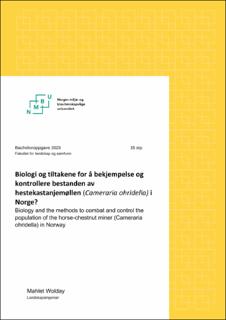| dc.contributor.advisor | Degvold, Frode | |
| dc.contributor.advisor | Johansen, Nina | |
| dc.contributor.author | Wolday, Mahlet Haile-Mariam | |
| dc.coverage.spatial | Norway | en_US |
| dc.date.accessioned | 2023-07-03T12:19:07Z | |
| dc.date.available | 2023-07-03T12:19:07Z | |
| dc.date.issued | 2023 | |
| dc.identifier.uri | https://hdl.handle.net/11250/3075369 | |
| dc.description.abstract | The topic of this bachelor's thesis is the invasive species horse-chestnut leaf-miner (Cameraria ohridella), its spread in Norway and measures against the horse-chestnut leaf miner that are suitable for Norwegian conditions. The horse-chestnut leaf miner has a parasitic relationship with horse-chestnut tree (Aesculus hippocastanum), the moth's larvae eat the mesophyll of the leaves, which weakness the tree's health, and its ability to winter harden, which increases the chance of frost damage. The flat mines the larvae create also destroy the ornamental value of the tree. If a horse-chestnut tree experiences moth attacks over several years, it will weaken the tree's growth and the tree may eventually die. The aim of the thesis will be to discuss methods to minimize the damage caused by the moth in green outdoor spaces, methods that can combat and control the population of the horse-chestnut leaf miner in Norway and reduce its spread further in the country. The paper will focus on the invasive species horse-chestnut leaf miner, but some of the strategies may be effective against many other species.
Therefore, in this thesis, I will also use a literature study to explain the biology and life cycle of the horse-chestnut leaf miner. To gain an understanding of why various measures work and why some do not, and to know how, if necessary, to use the same strategies on other species. Literature studies were also used to explore various measures against the horse-chestnut leaf miner and the advantages and disadvantages of the measures. To gain an insight into measures that have been implemented and experiences people have had with the horse-chestnut leaf miner, I have had conversations with; Oslo and Fredrikstad municipalities, park managers at NMBU, and a person struggling with horse-chestnut leaf-miner in their gardens.
My conclusion is that integrated pest management (IPM) and the removal and destruction of fallen leaves in autumn is the most effective options, as of today. As good implementation of IPM will minimize the possibility of attack by the horse-chestnut leaf miner and removal of fallen leaves because it is by remaining in the fallen leaves that the horse-chestnut leaf miner survives the winter. Chemical alternatives are not recommended even if they are used against the horse-chestnut leaf miner in other countries, the use of pesticides in public outdoor places is often illegal in Norway and the consequences of pesticides are not ideal. The biological measures, such as pheromone traps and the use of mushrooms, may become alternatives in the future, but more research must be done in the Norwegian climate before we can introduce these measures. | en_US |
| dc.description.abstract | Temaet for denne bacheloroppgaven er den invaderende arten hestekastanjemøll (Cameraria ohridella), dens utbredelse i Norge og tiltak mot hestekastanjemøllen som egner seg til norske forhold. Hestekastanjemøllen har et parasittisk forhold til hestekastanjetrær (Aesculus hippocastanum), møllens larver spiser mesofyllet og danner flatminer som svekker treets helse, evne til å vinterherde seg, som øker sjansen for frostskader, flatminene larvene lager ødelegger også treets prydverdi. Opplever et hestekastanjetre sterke angrep over flere år, vil det svekke veksten og treet kan eventuelt dø. Målet med oppgaven er å diskutere metoder for å minimere skadene gjort av møllen i grønne uterom, metoder som kan bekjempe og kontrollere bestanden av hestekastanjemøllen i Norge og minske spredning videre i landet. Oppgaven setter søkelys på den invaderende arten hestekastanjemøll, men noen av strategiene kan brukes mot mange andre arter.
Derfor vil jeg i denne oppgaven også benytte litteraturstudie for å redegjøre for hestekastanjemøllens biologi og livssyklus, for å få en forståelse over hvorfor ulike tiltak fungerer eller ikke og hvordan eventuelt bruke de samme strategiene på andre arter. Det ble også benyttet litteraturstudie for å finne ut av ulike tiltak mot hestekastanjemøllen og tiltakenes fordeler og ulemper. For å få et innblikk i tiltak som har blitt gjennomført og opplevelser folk har hatt med hestekastanjemøllen har jeg hatt samtaler med; Oslo-, Ås og Fredrikstad kommune, parkansvarlige på NMBU, og folk med hestekastanjemøll i hagen.
Den avsluttende konklusjonen ble at integrert plantevern (IPV) og det å fjerne og destruere løvfall på høsten er de mest effektive alternativet, per dags dato. Ettersom god gjennomføring av IPV vil minimere muligheten for angrep og fjerning av løvfall fordi det er i løvfallet hestekastanjemøllen overvintrer. Bruk av kjemiske plantevernmidler som et alternativ er ikke anbefalt selv om de brukes mot hestekastanjemøllen i andre land, bruk av sprøytemiddel i offentlige uteanlegg er ofte ulovlig i Norge og konsekvensene av sprøytemidler er ikke ideelle. De biologiske tiltakene som feromonfeller og bruk av sopp kan i fremtiden bli alternativer, men må forskes mer på i norsk klima før vi kan introdusere tiltakene. | en_US |
| dc.language.iso | nob | en_US |
| dc.publisher | Norwegian University of Life Sciences, Ås | en_US |
| dc.rights | Attribution-NonCommercial-NoDerivatives 4.0 Internasjonal | * |
| dc.rights | Attribution-NonCommercial-NoDerivatives 4.0 Internasjonal | * |
| dc.rights.uri | http://creativecommons.org/licenses/by-nc-nd/4.0/deed.no | * |
| dc.subject | Cameraria ohridella | en_US |
| dc.subject | Hestekastanjemøll | en_US |
| dc.subject | Horse-chestnut miner | en_US |
| dc.title | Tiltakene for å bekjempelse og kontrollere bestanden av hestekastanjemøll (Cameraria ohridella) i Norge | en_US |
| dc.title.alternative | The measures to combat and control the population of horse-chestnut miner (Cameraria ohridella) in Norway | en_US |
| dc.type | Bachelor thesis | en_US |
| dc.description.localcode | B-LI | en_US |

